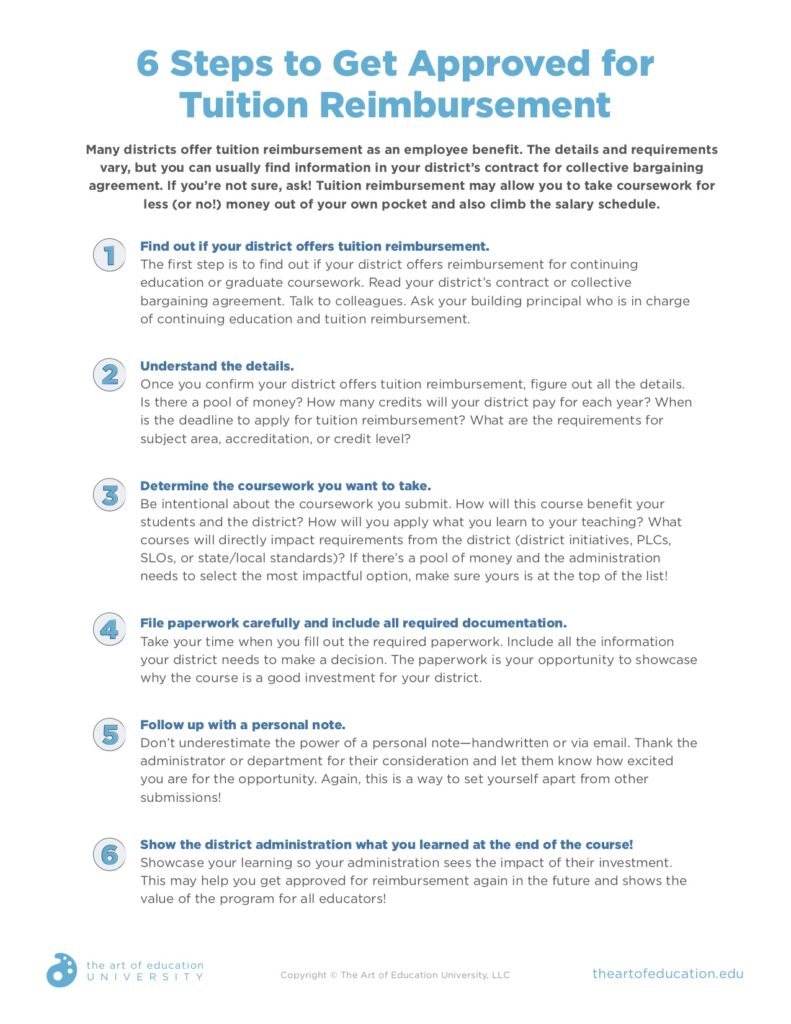Use these 6 steps to get a “yes” from your district so you can start to climb the salary schedule without paying the full tuition out of pocket!

Tuition reimbursement is an employee benefit offered by many school districts and companies. It is one of the most valuable—and underused—ways to pay for continuing education. A tuition reimbursement program shows that your district is invested in teachers’ professional growth. And for you, the employee, tuition reimbursement is not taxable income.
More often than not, schools with tuition reimbursement programs also offer salary advancement. This means your school will foot the bill so you can earn more!
Earning a higher degree is one of the best ways to advance your career and earn more money.
Learn more about how to leverage salary advancement here.
Let’s dive into the six steps for creating and submitting a successful tuition reimbursement proposal.
1. Find out what your school offers.
The first step is finding out if your school offers tuition reimbursement and exactly what is offered. The best place to find the details is in your contract or collective bargaining agreement if you have one. Finding the information in writing is the first step to creating a great proposal. If you can’t find the information, talk to colleagues in your school or ask your building principal where you can find the information.
If your school doesn’t offer tuition reimbursement, it doesn’t mean all hope is lost. Here are some ideas that might help:
- Ask about school-sponsored scholarship programs, perhaps through your district parent-teacher association.
- Ask your administrator if professional development funds can be applied toward graduate coursework, and if so, how much.
- If your school has a union, connect with your union leader, or join the collective bargaining team. Maybe you can help get a tuition reimbursement program written into the next contract!
2. Understand the details.
Once you’ve determined your school has a tuition reimbursement program, it’s time to dive into the details. This will be time-intensive. Invest the energy needed to understand exactly what your school requires.
Here are some questions to ask:
- Who is eligible for tuition reimbursement?
- Is funding awarded by seniority, first-come, first-served, or something else?
- Is there a limit to how much tuition reimbursement the district offers to employees?
- How many credits will the district pay for each year?
- What is the maximum amount per credit they will reimburse?
- When is the deadline to submit?
- How do you apply?
- Is there a pre-approval process, or do you submit the request after the course is finished?
- Does the district have requirements for the coursework (i.e., must be a part of a degree program, must be related to the teacher’s subject area, etc.)?
- Do you need to earn a specific grade to be reimbursed? What do you need to submit to prove that grade?
- How long does it take for the district to reimburse you?
Getting the answers to these questions helps you submit a great proposal with all the necessary information.
It’s important to remember that the institution you attend needs to process your grades for documentation (usually an official transcript). If your school district has a deadline for tuition reimbursement, be sure the course ends a few weeks before so you can file your paperwork on time. The Art of Education University processes grades within ten days of the course end date. Electronic transcripts generally take twenty-four to forty-eight hours to be filled.
3. Be selective and strategic with courses.
Now comes the fun part! When your school reimburses you for coursework, they are investing in your professional growth and your future. To make sure you get a “yes,” show the district how the course will benefit the district.

What are your district’s goals?
Use this download to help you brainstorm.
- Think about buzzwords and district initiatives.
- Review your district’s website. What stands out?
- Review recent board meeting minutes to determine where your district wants to go in the future.
- Some schools even post their strategic plan for the next five to ten years.
Choose a course that aligns with the big goals and make it easy for them to say, “Yes.” For example, if the district is focused on social-emotional learning, find a course that allows you to develop a curriculum and resources that will directly impact students’ SEL outcomes. Art Therapy for Art Teachers would help you align with that goal. Or, if your district is going to offer universal pre-K and kindergarten programs, take a course focused on early childhood development, like Rethinking Kindergarten.
Align as closely as you can with the district’s big goals, especially if it’s your first time requesting tuition reimbursement.
4. File your paperwork carefully.
Get all the information your district requires. Don’t leave anything blank – and if you’re not sure, reach out to the university to get what you need – a copy of the syllabus, the course code, run dates, and outcomes. If you’re taking courses at AOEU and you don’t have exactly what you need, reach out to us. We are here to help you get access to the rigorous, relevant coursework you deserve.

Also, don’t underestimate the power of a polished, professional submission. If it’s handwritten, write neatly. If it’s a digital submission, be sure it’s formatted correctly and spell-checked.
Hand-deliver your paperwork if you can. Putting a face with a name will make you more memorable than a packet that arrives through interoffice mail.
5. Send a personal follow-up.
The power of a personal thank-you note goes a long way. Use this opportunity to show gratitude for the tuition reimbursement program and the potential for you to apply it to your graduate work.
Think of this process like you would a job interview or requesting a raise. You have a better chance of being selected if you can stand out from the crowd. If a thank-you note doesn’t work, a quick email can be just as effective.
6. Showcase what you learned.
Hooray! If you get approved for tuition reimbursement, don’t let the process end there. Show your district they made a great choice, and they may be more likely to fund more coursework for you in the future.

Here are 3 ways you can show the impact of your coursework:
- Demonstrate student learning—Take pictures and put them on your art room’s social media page, the district’s website, or the school newsletter. Write a note to school board members outlining the ways your learning impacted your students.
- Share with colleagues—Share what you learned with the other art teachers in your district. Volunteer to hold a session at an upcoming PD day or faculty meeting. Bring new learning to non-art teachers if it’s applicable. Showcase yourself as a leader and a cornerstone in the school community.
- Share outside your school—Tell parents and guardians how the district supports continuing teacher education. Submit a proposal to present at a conference or write about your learning in an educational publication. You can even share it with local newspapers and news channels.
Show your district they made a great choice to fund your education. Give them the “good press” so you, or other teachers, can take advantage of tuition reimbursement in the future.
Click here to download the 6 steps at a glance!
If your school offers tuition reimbursement, don’t leave that money on the table. Show your school district your professional growth is beneficial for the school and your students, and their investment is worth it. At the same time, you can build your resume, reignite your passion for learning, and you might even earn more money.
How much does your school district pay for tuition reimbursement?
What’s holding you back from continuing your education and earning more money?
Magazine articles and podcasts are opinions of professional education contributors and do not necessarily represent the position of the Art of Education University (AOEU) or its academic offerings. Contributors use terms in the way they are most often talked about in the scope of their educational experiences.






